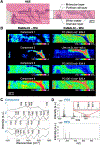RaMALDI: Enabling simultaneous Raman and MALDI imaging of the same tissue section
- PMID: 37597501
- PMCID: PMC10544780
- DOI: 10.1016/j.bios.2023.115597
RaMALDI: Enabling simultaneous Raman and MALDI imaging of the same tissue section
Abstract
Multimodal tissue imaging techniques that integrate two complementary modalities are powerful discovery tools for unraveling biological processes and identifying biomarkers of disease. Combining Raman spectroscopic imaging (RSI) and matrix-assisted laser-desorption/ionization (MALDI) mass spectrometry imaging (MSI) to obtain fused images with the advantages of both modalities has the potential of providing spatially resolved, sensitive, specific biomolecular information, but has so far involved two separate sample preparations, or even consecutive tissue sections for RSI and MALDI MSI, resulting in images with inherent disparities. We have developed RaMALDI, a streamlined, integrated, multimodal imaging workflow of RSI and MALDI MSI, performed on a single tissue section with one sample preparation protocol. We show that RaMALDI imaging of various tissues effectively integrates molecular information acquired from both RSI and MALDI MSI of the same sample, which will drive discoveries in cell biology, biomedicine, and pathology, and advance tissue diagnostics.
Keywords: MALDI; Mass spectrometry imaging; Matrix; Multimodal imaging; Raman spectroscopy.
Copyright © 2023 Elsevier B.V. All rights reserved.
Conflict of interest statement
Declaration of competing interest The authors declare that they have no known competing financial interests or personal relationships that could have appeared to influence the work reported in this paper.
Figures





Similar articles
-
Multimodal imaging of biological tissues using combined MALDI and NAPA-LDI mass spectrometry for enhanced molecular coverage.Analyst. 2020 Oct 26;145(21):6910-6918. doi: 10.1039/d0an00836b. Analyst. 2020. PMID: 32840500
-
Towards developing a matrix-assisted laser desorption/ionization mass spectrometry imaging (MALDI MSI) compatible tissue expansion protocol.Anal Chim Acta. 2024 Apr 8;1297:342345. doi: 10.1016/j.aca.2024.342345. Epub 2024 Feb 10. Anal Chim Acta. 2024. PMID: 38438227
-
Multimodal Chemical Analysis of the Brain by High Mass Resolution Mass Spectrometry and Infrared Spectroscopic Imaging.Anal Chem. 2018 Oct 2;90(19):11572-11580. doi: 10.1021/acs.analchem.8b02913. Epub 2018 Sep 19. Anal Chem. 2018. PMID: 30188687 Free PMC article.
-
Multi-modal mass spectrometry imaging of a single tissue section.J Mass Spectrom. 2024 Aug;59(8):e5074. doi: 10.1002/jms.5074. J Mass Spectrom. 2024. PMID: 39017393 Review.
-
MALDI-MSI Towards Multimodal Imaging: Challenges and Perspectives.Front Chem. 2022 May 9;10:904688. doi: 10.3389/fchem.2022.904688. eCollection 2022. Front Chem. 2022. PMID: 35615316 Free PMC article. Review.
Cited by
-
Seeing is Believing: Developing Multimodal Metabolic Insights at the Molecular Level.ACS Cent Sci. 2024 Mar 21;10(4):758-774. doi: 10.1021/acscentsci.3c01438. eCollection 2024 Apr 24. ACS Cent Sci. 2024. PMID: 38680555 Free PMC article. Review.
-
Imaging and spatially resolved mass spectrometry applications in nephrology.Nat Rev Nephrol. 2025 Jun;21(6):399-416. doi: 10.1038/s41581-025-00946-1. Epub 2025 Mar 27. Nat Rev Nephrol. 2025. PMID: 40148534 Review.
-
Multimodal Mass Spectrometry Imaging in Atlas Building: A Review.Semin Nephrol. 2024 Nov;44(6):151578. doi: 10.1016/j.semnephrol.2025.151578. Epub 2025 Apr 16. Semin Nephrol. 2024. PMID: 40246671 Free PMC article. Review.
-
Correlative Raman Imaging: Development and Cancer Applications.Biosensors (Basel). 2024 Jun 28;14(7):324. doi: 10.3390/bios14070324. Biosensors (Basel). 2024. PMID: 39056600 Free PMC article. Review.
-
Sweet Science: Exploring the Impact of Fructose and Glucose on Brown Adipocyte Differentiation Using Optical Diffraction Tomography.J Cell Biochem. 2025 Jun;126(6):e70052. doi: 10.1002/jcb.70052. J Cell Biochem. 2025. PMID: 40583297 Free PMC article.
References
-
- Ahlf DR, Masyuko RN, Hummon AB, Bohn PW, 2014. Correlated mass spectrometry imaging and confocal Raman microscopy for studies of three-dimensional cell culture sections. Analyst 139(18), 4578–4585. - PubMed
-
- Ali A, Abouleila Y, Germond A, 2020. An integrated Raman spectroscopy and mass spectrometry platform to study single-cell drug uptake, metabolism, and effects. JoVE (155), e60449. - PubMed
-
- Barry JA, Groseclose MR, Castellino S, 2019. Quantification and assessment of detection capability in imaging mass spectrometry using a revised mimetic tissue model. Bioanalysis 11(11), 1099–1116. - PubMed
MeSH terms
Grants and funding
LinkOut - more resources
Full Text Sources

